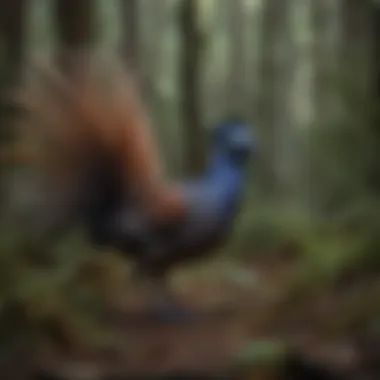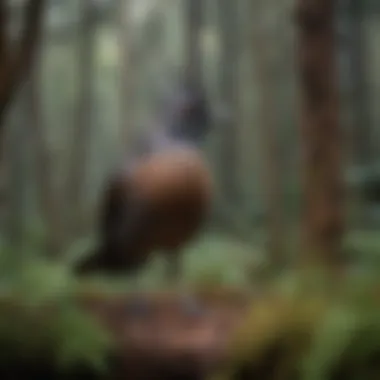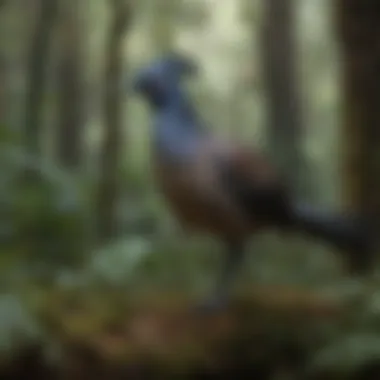Understanding the Lyrebird: An In-Depth Exploration


Intro
The lyrebird, a strikingly unique avian species, stands out not only for its stunning appearance but also for its unmatched mimicry abilities. Native to Australia, there are two main species: the superb lyrebird and the Albert's lyrebird, both showcasing a particular charm that captivates bird enthusiasts and the general public alike. Their ability to imitate a variety of sounds, from other birds to human-made noises, has drawn substantial attention in both scientific realms and popular media.
Understanding the nuances of the lyrebird, including its behaviors and ecological significance, is essential for those interested in avian life. This article aims to delve into various aspects of the lyrebird, highlighting its unique biological characteristics, behavioral habits, and the pressing issues that threaten its existence. Through this exploration, readers will gain a deeper appreciation for this remarkable species and the role it plays within its habitat.
Of particular interest are the implications of its mimicry skills. These not only play a significant role in mating rituals but also contribute to the species' survival in the wild. The lyrebird's portrayal in culture and media reflects a broader fascination with this exceptional bird, underscoring its importance in both ecological and cultural narratives.
The aim of this piece is not just to inform but to enhance the reader's understanding of a creature that epitomizes the wonders of avian life.
Foreword to the Lyrebird
The lyrebird is a captivating avian species that stands out due to its remarkable ability to mimic various sounds. This feature not only underscores its unique behavioral traits but also demonstrates its adaptability in diverse habitats. For pet bird owners and aspiring bird parents, understanding the lyrebird's characteristics aids in appreciating its exceptional qualities.
These birds are native to Australia, and they play significant roles in their ecosystems. Their mimicry skills are not merely for show; they serve practical purposes in communication and social interaction.
In this article, we delve deeper into each significant aspect of the lyrebird's life. By examining taxonimy, physical traits, behavior, and their impact on the environment, we can gain insight into how they operate within their natural world. Additionally, we address the conservation efforts to protect this species, which is increasingly threatened by habitat loss and other factors. The cultural significance of the lyrebird also warrants attention; its representation in media reflects its importance in human fascination with nature.
Understanding the lyrebird goes beyond appreciating its beauty. It helps decode the complex interplay of species within ecosystems, enlightening us on the significance of biodiversity. As we explore these themes, a better comprehension of not just the lyrebird but of ecological interconnectedness emerges.
"The lyrebird’s mimicry is not just a talent; it is an evolutionary adaptation that is integral to its existence."
Taxonomy of the Lyrebird
The taxonomy of the lyrebird plays a crucial role in understanding its unique characteristics and evolutionary context. Taxonomy refers to the classification system that organizes living organisms into groups based on shared features. For the lyrebird, this classification aids in identifying its relationships with other species. It highlights the distinct traits that set the lyrebird apart, such as its exceptional mimicking abilities, social behaviors, and ecological role. Understanding its taxonomy is essential for both conservation efforts and aviculture, as it informs practices related to breeding and habitat preservation.
Genus and Species
The lyrebird belongs to the genus Menura, with two primary species recognized: the superb lyrebird (Menura superb) and the Australian lyrebird (Menura ground). Each species exhibits unique features and adaptations adapted to their environments.
- Superb Lyrebird: Noted for its elaborate plumage and complex courtship displays. Males possess tail feathers that resemble a lyre, used to attract mates through visual and auditory signals.
- Australian Lyrebird: More adaptable in terms of habitat, it exhibits similar mimicking capabilities but is less ostentatious than its superb counterpart.
Understanding these species allows pet bird owners and breeders to appreciate the nuances in their care and behavior, emphasizing the need for tailored approaches to husbandry and well-being.
Phylogenetic Relationships
The phylogenetic relationships of lyrebirds trace their evolutionary lineage back to ancient ancestors, showcasing their development and diversification over time. Recent studies suggest that lyrebirds share a close connection with the family of Australian passerines, which includes renowned mimics like the magpies and honeyeaters.
- Shared Traits: A key characteristic among these species is their ability to imitate sounds from their environments. This mimicking ability not only aids in communication but also plays a role in survival by deceiving potential predators.
- Evolutionary Insights: Research indicates that these birds adapted to various Australian ecosystems, leading to distinct adaptations and behaviors. Understanding these relationships helps aviculturalists in breeding programs by ensuring genetic diversity and promoting healthy populations.
Physical Characteristics
The physical characteristics of the lyrebird are integral to understanding this unique species. These details are not only fascinating but also provide insights into their behavior, adaptability, and ecological roles. Knowledge about their size, feather structure, and vocal apparatus enhances appreciation for their mimicking abilities and courtship displays. Each characteristic plays a significant role in how lyrebirds interact with their environment and with one another, influencing everything from survival to reproductive success.
Size and Weight
Lyrebirds exhibit a range of sizes, but they generally display a remarkable balance between size and weight. Adult male superb lyrebirds can reach lengths of 80 centimeters, while females are slightly smaller. This size variation is notable as it is often associated with sexual dimorphism. Their weight typically ranges from 700 to 1,200 grams. The substantial size of males, particularly during their courtship displays, gives them a distinct advantage in attracting females.
The impressive tail feathers, which can be more than half of their total length, expand into a beautiful display during mating rituals. This elaborate display is key for communication and can influence mate selection. The physical size of the male lyrebird is a vital factor contributing to its role in the ecosystem, affecting its mobility and foraging strategies.
Feather Structure and Colors
The feather structure of the lyrebird is complex and contributes significantly to its visual appeal and survival tactics. Their plumage is intricately designed with a combination of brown, black, and golden hues, allowing them to blend in seamlessly with their forest environments. This camouflage is crucial for evading predators and enhancing their hunting strategies.
The outer feathers of the male lyrebird can display a stunning iridescent effect, particularly during sunlight exposure. This coloration not only attracts potential mates but also serves a functional role in signaling health and vigor. In contrast, females typically possess less vibrantly colored feathers, which aids in nesting and raising chicks without attracting unnecessary attention.
Vocal Apparatus
The vocal apparatus of lyrebirds is perhaps their most remarkable physical trait. Their syrinx, located at the base of the trachea, is highly developed and allows for an exceptional range of sounds. These can include not only their own calls but also mimics of other birds and even mechanical sounds from their environment. This astonishing ability to imitate is a major component of their survival and reproductive success.
The intricacies of the lyrebird's vocal structure enable it to produce a diverse array of sounds that can vary significantly in pitch, tone, and complexity. Males often engage in vocal duels during breeding season, showcasing their mimicking prowess to attract female partners. This vocal exhibition not only highlights their genetic fitness but also plays an important role in establishing territory.
The lyrebird's vocal capabilities can mimic natural sounds with remarkable accuracy, from chainsaws to camera shutters, demonstrating their adaptability to human-altered environments.
In summary, understanding the physical characteristics of the lyrebird offers valuable insights into its biological and ecological significance. By appreciating these traits, we can better comprehend the nuances of their behavior and role in the ecosystem.
Habitat and Distribution
The habitat and distribution of the lyrebird are essential aspects that reveal much about its existence and its role in the environment. Understanding these factors is crucial for anyone interested in avian studies or considering the lyrebird as a companion animal. The lyrebird thrives in specific ecosystems and is adapted to particular environmental conditions. This section will discuss the preferred environments of the lyrebird and its geographical range, providing insights into how these factors influence its behavior and survival.
Preferred Environments
Lyrebirds inhabit a variety of environments, although they are predominantly found in southeastern Australia. They favor dense forests and woodlands, particularly areas with ample understory vegetation where they find shelter and food. The cover of foliage helps to protect them from predators and extreme weather.


Key characteristics of their preferred environments include:
- Rich Flora: The availability of diverse plant species is important. Lyrebirds often forage in leaf litter, looking for insects, seeds, and small fruits.
- Moist Conditions: They thrive in areas with moderate rainfall. This moisture supports a healthy ecosystem, ensuring their food sources are abundant.
- Acoustic Properties: Dense environments allow the lyrebird to engage in its impressive vocal displays. The acoustics of their habitats amplify their songs and mimicry, which is crucial during courtship.
These environments not only provide essential resources but also influence the social dynamics of lyrebirds, affecting their interactions with each other and with potential mates.
Geographical Range
The geographical range of the lyrebird is relatively limited when considering their overall habitat preferences. The two primary species, the superb lyrebird and the Albert’s lyrebird, are distributed across different areas of southeastern Australia.
- Superb Lyrebird: This species is found primarily in Victoria, New South Wales, and parts of Tasmania. They occupy a range of habitats, from coastal regions to mountainous areas, reflecting their adaptability to varying forest types.
- Albert’s Lyrebird: In contrast, the Albert's lyrebird is more localized, primarily residing in the rainforests of southeastern Queensland. Their preference for these moist, dense forests underscores their specific ecological requirements.
The distribution patterns of the lyrebird are significant for understanding their conservation status. The fragmentation of suitable habitats due to human activities poses threats to these birds. As their range is limited, even minor habitat loss can have sweeping effects on local populations.
Understanding the habitat preferences and geographical distribution of the lyrebird is fundamental in implementing effective conservation strategies. Protecting their ecosystems ensures that the lyrebird can thrive and continue to be a part of the avian biodiversity in Australia.
Behavioral Traits
Understanding the behavioral traits of the lyrebird is crucial for appreciating its unique ecological niche and social dynamics. These traits reflect how lyrebirds interact with their environment and each other. The ability to observe and interpret these behaviors can offer insights not just about the species itself, but also about avian communication and social structure.
Social Structure
Lyrebirds exhibit intricate social structures that hinge on territory and mating behaviors. Male lyrebirds establish territories during the breeding season. They perform elaborate calls and displays to attract females. This competition among males is intense, shaping their social interactions and hierarchical organization. Each male defends a specific area and uses its vocal abilities as a strategy to assert dominance over rivals.
The social structure of lyrebirds can be classified into loose hierarchies based on displayed power and prowess in mimicry. Males that can reproduce a wide range of sounds and mimicry are often more successful in attracting mates. Additionally, females can be selective, choosing males based not only on their vocal displays but also on the quality of their nesting areas.
Communication Methods
The communication methods of lyrebirds stand out due to their exceptional mimicry. They utilize a complex vocal language that plays an essential role in their social interaction. Lyrebirds can imitate a vast array of sounds, including other bird calls, mechanical noises, and even human-made sounds. This ability serves multiple purposes, from attracting mates to establishing territory.
Communication is not limited to sounds. Body language and behaviors during courtship rituals also convey information. For instance, males often engage in elaborate displays that showcase their plumage. These performances are essential for signaling fitness and attracting female interest. Additionally, vocalizations can help establish dominance within social groups.
Reproductive Behavior
The reproductive behavior of the lyrebird is a critical aspect of its life cycle, influencing not only its offspring but also the sustainability of the species. This behavior encompasses various elements, including mating rituals and nesting habits, that play a pivotal role in the survival of young birds and the continuation of the species. Lyrebirds are known for their complex courtship displays, which help males attract females. These displays are not merely about physical presence; they are also a demonstration of genetic fitness and adaptability.
Courtship Displays
During the breeding season, male lyrebirds engage in elaborate courtship displays. These displays are characterized by striking physical movements and intricate vocalizations. The peacock-like tail feathers of the male lyrebird are crucial during these displays. Males fan out their tails and perform various actions that can attract the attention of potential partners.
- Vocalizations: Males are capable of mimicking the sounds of other birds and natural environments. This includes replicating chainsaws, camera shutters, and even human voices. Such mimicry illustrates not just their vocal ability but also indicates a healthy and strong genetic background.
- Physical Movement: The accompanying dance is equally important. Males often hop, turn and spread their feathers. These movements are visually captivating and display vigor and health, thereby enticing females.
"The combination of vocal and visual elements in the male lyrebird's display is a testament to its evolutionary adaptation and a key to reproductive success."
The effectiveness of these courtship displays is closely linked to the male's ability to showcase the diversity of sounds he can mimic. Research indicates that females are more likely to choose mates that exhibit a wide range of mimicry, as it suggests superior genetic quality.
Nesting Habits
Once mating is successful, the focus turns to nesting habits. Female lyrebirds take the lead in constructing the nest. The nest is typically built in dense underbrush, offering protection from predators and harsh elements.
- Nest Construction: Females gather materials such as twigs, leaves, and grass to create a secure structure. The location and construction method are vital, as they help ensure the safety of the eggs and later the chicks.
- Egg Laying: Typically, the female lays one to three eggs in a clutch. The timing of the laying is crucial because it usually aligns with the abundance of food sources available during the warmer months.
- Incubation and Care: The female incubates the eggs, which hatches after about 6 weeks. Post-hatching, both parents play a role in feeding the chicks, although the female predominantly stays with them as they grow. This nurturing phase is essential for the survival of the young birds until they are ready to fledge.
The reproductive behavior of lyrebirds is not just about continuing the lineage; it is integral to their ecological role and preservation. Understanding these behaviors provides insight into the challenges they face in the wild due to habitat loss and environmental changes.
Mimicry and Vocalization
Mimicry and vocalization are central themes in the study of the lyrebird. These aspects define much of the bird's identity and are crucial for various interactions within its environment. The lyrebird exhibits an extraordinary ability to imitate natural and artificial sounds. This capacity serves multifaceted purposes, including communication, attracting mates, and establishing territory. Moreover, understanding mimicry can provide insights into the bird's adaptations and survival strategies in its natural habitat.
Techniques of Mimicry
The lyrebird employs varied techniques of mimicry. It mimics sounds from its surroundings, which can include everything from the calls of other bird species to mechanical noises like camera shutters or chainsaws. The process is often complex and involves learning from both innate and external sources.
- Learning Phase: Lyrebirds begin learning sounds at a young age. They listen intently to their environment and practice mimicking these sounds throughout their life.
- Sound Mimicry: They have excellent auditory memory, allowing them to replicate sounds with remarkable precision. Some individuals can imitate dozens of different calls from surrounding species.
- Performance Context: During mating season, male lyrebirds will often put on elaborate displays. They combine visual signals with vocal mimicry to attract females. This performance can include imitations of rival males, which showcases not only their mimicry skills but their fitness as well.
The intricacy of these techniques highlights the bird's cognitive abilities and social adaptations. The ability of lyrebirds to learn and reproduce diverse sounds is a testament to their role as a key player in their ecosystems.
Significance of Mimicking Skills
The mimicking skills of lyrebirds serve several significant functions within their ecosystem.
- Mate Attraction: Male lyrebirds utilize their vocal skills to show off to potential mates. A male that can imitate a wide array of sounds is often more successful in attracting a female. Elevated mimicry can indicate genetic fitness, suggesting that the bird can thrive in a competitive environment.
- Territorial Defense: By mimicking the calls of other birds, lyrebirds can deter competitors from entering their territory. This behavior can lead to fewer conflicts and more resources for feeding and breeding.
- Ecosystem Impact: Through their vocalizations, lyrebirds play a vital role in their ecosystem by helping to sustain the balance among species. Their ability to mimic helps maintain communication networks among bird populations.
- Cultural Significance: Beyond biological interactions, lyrebird mimicry has entered human culture, inspiring artists and researchers alike. Its capabilities have made it a subject of fascination in studies on animal behavior and communication.
In summary, the mimicry and vocalization methods of the lyrebird not only enhance its chances of survival but also establish it as a focal point in discussions of biodiversity and ecological significance.
"The lyrebird's vocal prowess is not just a display of talent but a complex adaptation that showcases evolutionary benefits essential for its survival."


Understanding these elements fosters a deeper appreciation for the lyrebird's role, both in nature and in cultural contexts.
Ecological Roles
The lyrebird plays a crucial role in the ecosystem, marking its significance beyond mere aesthetics or entertainment. As both a predator and prey, they maintain a balance within their habitats. They contribute to seed dispersal through their feeding habits. This allows various plant species to thrive in different areas, enhancing biodiversity. Their interactions with flora are indirect yet vital for the health of their environments.
Impact on Ecosystems
Lyrebirds influence several ecological processes. Their intricate foraging behaviors help control insect populations. This is beneficial for plant life, as many insects can be harmful to vegetation. By regulating these populations, lyrebirds indirectly protect plant health and promote growth. Moreover, the presence of lyrebirds indicates a healthy ecosystem. They are sensitive to environmental changes. Thus, observing their populations can signal shifts in habitat quality. When they thrive, it's a good sign of ecological stability.
Lyrebirds also contribute to the intricate food web. They serve as prey for larger predators, such as foxes and hawks. Their existence supports other species, highlighting the interconnectedness of life in the ecosystem. This interdependence is crucial for maintaining balance within their ecological niche.
"The health of an ecosystem can often be gauged by the diversity and abundance of its native species, such as the lyrebird."
Interactions with Other Species
Interactions between lyrebirds and other species are multifaceted. For birds, they compete for food and territory with other avian species. However, their mimicking abilities can also function as a communication tool. By imitating the calls of other birds, they can scare away competitors. This showcases their adaptiveness and resourcefulness in a competitive environment.
Additionally, these birds influence the behavior of other wildlife. Their vocalizations can serve as indicators for other species, alerting them to potential dangers or food sources. Such dynamics underline the lyrebird's role in the food web.
Lyrebirds also have a symbiotic relationship with various insects. The insects they consume help to control pest populations. Conversely, the waste produced by lyrebirds can aid in soil enrichment. This leads to healthier plant life and supports overall ecosystem productivity. The relationships they foster highlight the interconnected nature of ecological communities.
Conservation Status
The conservation status of the lyrebird is a crucial aspect within the framework of this article. Recognizing the threats faced by this unique species helps us appreciate its intricacies while highlighting the need for protective measures. The lyrebird is not only a remarkable creature in terms of its mimicking abilities but also plays a significant role in its ecosystem. Therefore, understanding its conservation status informs us about biodiversity and our responsibilities toward it.
Threats to Population
The challenges to the lyrebird population are complex and multifaceted. Among the key threats are habitat loss and fragmentation. Urban development, agriculture, and logging activities lead to severe degradation of their natural habitats, making it difficult for these birds to thrive. The introduction of invasive species also adds to their plight, as these species can outcompete native wildlife for food and resources.
Additional factors include climate change, which alters their environment and affects food availability. Increased temperatures and changing weather patterns can have cascading effects on their breeding and feeding habits. Also, pollution, especially in the form of chemicals used in agriculture, poses health risks to the lyrebird, impacting their survival.
Here are some notable threats:
- Habitat loss due to urbanization and agriculture
- Invasive species competing for resources
- Climate change altering ecosystems
- Pollution affecting health and reproduction
Conservation Efforts
Efforts to conserve the lyrebird and its habitat involve a combination of public awareness campaigns, habitat restoration projects, and legislative preservation measures. Various environmental organizations are working tirelessly to protect these birds and promote their well-being. Public education plays a significant role in fostering a community that understands the value of preserving wildlife.
In addition, local governments have initiated several habitat restoration projects that aim to rehabilitate areas previously degraded by human activity. These projects often involve planting native vegetation and removing invasive species to create a more hospitable environment for the lyrebirds.
Legislation such as the Environment Protection and Biodiversity Conservation Act serves to safeguard natural habitats from destructive practices. Groups like BirdLife Australia are instrumental in advocating for policy changes that can bolster conservation efforts.
Key conservation strategies include:
- Public education and awareness campaigns
- Habitat restoration projects
- Legislative protection of natural habitats
- Collaboration with local communities to promote sustainable practices
"Conservation is not just about saving a species; it's about nurturing a healthy ecosystem that supports all life forms."
Cultural Significance
The lyrebird holds a notable position in various cultural contexts, especially among indigenous communities in Australia. This section emphasizes the vital role that the lyrebird plays not only in natural ecosystems but also in cultural narratives and artistic expressions. By examining its cultural significance, one can appreciate the depth of human connection to this unique avian species and understand the implications of its existence beyond mere biological classification.
Lyrebird in Indigenous Culture
In indigenous Australian culture, the lyrebird is often regarded as a powerful symbol. Various Aboriginal groups have incorporated this bird into their folklore and storytelling, reflecting its remarkable mimicking ability. Some stories portray the lyrebird as a wise and clever creature. It is often featured in songs and dances, which celebrate the community's connection to the land and its wildlife.
Moreover, the lyrebird’s vocal mimicry is sometimes seen as a metaphor for communication skills among humans. These cultural narratives help instill respect for nature while emphasizing biodiversity. This connection to the traditional ways of life showcases how lyrebirds are not just birds within an ecosystem; they represent interconnected lives and the ongoing relationship between people and their environment.
Representation in Modern Media
In contemporary culture, the lyrebird has found its way into various forms of media. Documentaries and wildlife shows regularly highlight its extraordinary ability to mimic sounds from its surroundings. These portrayals are essential for raising awareness about this species and its significance in ecosystems. The lyrebird appears in advertisements, animations, and art, further solidifying its presence in the public consciousness.
The depiction of lyrebirds often serves as an entry point to discuss broader themes, such as the impacts of habitat loss and the importance of conservation efforts. By featuring such an exceptional creature, media representations can foster a deeper understanding and commitment to preserving biodiversity.
"The lyrebird's ability to mimic its surroundings resonates with the broader human experience of communication and adaptation in society."
In summary, the cultural significance of the lyrebird reflects a blend of historical values and modern awareness. This dynamic allows various audiences, from indigenous communities to global audiences, to appreciate the role of the lyrebird in human culture and the environment.
Lyrebird in Aviculture
The lyrebird has captured the interest of bird enthusiasts and aviculturists alike due to its remarkable abilities and striking appearance. Keeping lyrebirds as pets, while not common, can offer a unique experience for those interested in aviculture. Understanding the considerations and requirements of caring for these birds is essential for their wellbeing and the enjoyment of their owners.
Keeping Lyrebirds as Pet Birds


Keeping a lyrebird as a pet is a significant commitment. Firstly, it is crucial to understand that these birds are not like traditional pets. Lyrebirds are known for their complex vocalizations and mimicry, traits that fascinate many. However, they require specific environments and care that can be challenging to replicate in a home setting.
The first step in deciding to keep a lyrebird is ensuring the legality of owning such a species in your area. Some regions have restrictions on keeping wild birds as pets. Additionally, many licensed breeders may offer these birds to potential owners, emphasizing the importance of acquiring them from reputable sources.
Lyrebirds thrive in environments that mimic their natural habitat. They need ample space to move around and engage in behaviors they would typically exhibit in the wild. Regular social interaction with their owners is also beneficial, as these birds can become quite sociable. It is essential, however, to foster this relationship gradually, respecting the bird's need for adjustment and space.
Best Practices for Care
Taking care of a lyrebird involves various considerations to ensure their health and happiness. Here are some best practices to keep in mind:
- Diet: A balanced diet is fundamental. Lyrebirds are omnivorous, so their diet should include high-quality seeds, fresh fruits, and vegetables. Regular access to clean water is also critical.
- Environment: Create a safe enclosure that provides space for flight and climbing. Use natural branches, as these can simulate their natural habitat. Ensure the space is enriched with toys and activities to keep the bird stimulated.
- Health Care: Regular health check-ups with an avian veterinarian are recommended. This ensures that any potential health issues are identified early. Additionally, vaccination and parasite control should be parts of their health regimen.
- Social Interaction: Spend time each day engaging with your lyrebird. Mimicry is a critical part of their communication. They learn from their environment, including the sounds they hear. Speaking to them often helps build a strong bond.
"Lyrebirds require specific environments and care that can be challenging to replicate in a home setting."
Research and Studies
Research on the lyrebird is vital for understanding its unique behaviors, ecological significance, and conservation needs. Studies into its mimicry, social structures, and environmental interactions provide insights not only into the species but also into the health of the ecosystems they inhabit. Moreover, these studies help inform conservation efforts which are crucial for the preservation of this remarkable bird, especially given the threats it faces in its natural habitat. Recognizing the importance of ongoing and historical research can enrich pet bird owners and breeders' approach to care and breeding, as they can learn from the behaviors and needs highlighted in these studies.
Key Studies on Lyrebird Behavior
A variety of significant studies have contributed to the current understanding of lyrebird behavior. For example, one foundational research by Dr. John W. Smith in the 1990s focused on the complex social structures of the lyrebird. This study explored how males use their mimicry during courtship and the impact of social interactions on their song variability. The findings demonstrated that males who could mimic a wider array of sounds, including environmental noises and other birds' calls, were more successful in attracting mates.
Another pivotal research initiative by Dr. Hannah Jones investigated the vocal learning processes of lyrebirds. This study revealed that lyrebirds learn mimicry in a context-dependent manner, adjusting their calls based on social environments. This not only highlights their adaptability but also emphasizes the cognitive complexities underlying their vocalizations. Such insights are crucial for bird owners, as understanding these behaviors can lead to better management and enrichment practices for captive birds.
Ongoing Research Initiatives
Currently, research initiatives are continuing to examine the lyrebird's role in its ecosystem as well as the implications of environmental changes on their populations. One prominent project, funded by the Australian National Science Agency, focuses on monitoring habitat preferences and changes in population dynamics due to habitat destruction and climate change. The findings are important for pet bird owners and breeders who wish to emulate suitable environments for their animals in aviculture.
Moreover, new studies are exploring the effects of various conservation strategies. This includes the establishment of protected areas and their impact on lyrebird populations. Researchers analyze whether these measures successfully protect the species and how they influence the birds' natural behaviors. They provide essential data which can direct future conservation agendas, making this research particularly relevant to stakeholders in aviculture and environmental conservation efforts, helping to align pet care with best practices derived from scientific insights.
Lyrebird in Global Context
The understanding of the lyrebird in a global context is vital due to its unique ecological roles and distinctive characteristics. Analyzing the lyrebird alongside other bird species offers insight into its adaptations and survival strategies. This analysis also helps frame the lyrebird's place in biodiversity and conservation efforts.
Comparison with Other Bird Species
The lyrebird stands out among various avian species due to its remarkable mimicking abilities. Unlike most birds that have standard calls, the lyrebird can imitate a wide range of sounds, including other birds, human-made noises, and environmental sounds. This adaptability highlights the lyrebird's evolutionary advantages.
When comparing lyrebirds to other birds like mockingbirds or parrots, one can see distinct differences in mimicry approaches. Mockingbirds typically use imitation as part of their territorial displays but lack the biological mechanisms that produce the range of sounds the lyrebird can make. Parrots, meanwhile, are known for their vocal mimicry, yet they do not use it in the same intricate courtship rituals as the lyrebird does.
Additionally, the lyrebird’s physical adornments and mating displays are unparalleled. The male lyrebird's tail feathers fan out into a spectacular display during courtship, contrasting sharply with many species where such elaborate displays are absent.
Lyrebird's Role in Biodiversity
The lyrebird plays a crucial role in maintaining the balance within its ecosystem. This bird contributes to seed dispersal and insect population control. By mimicking signals from potential predators, it also serves as a warning signal for other species in the area, helping to enhance the overall awareness and survival of various wildlife. This mimicry fosters a symbiotic relationship with its environment, proving beneficial for both the lyrebird and its ecosystem.
Maintaining biodiversity is essential for ecosystem stability. The loss of any key species can disrupt food chains and the health of habitats. The lyrebird's decline may indicate larger environmental issues at play, such as habitat destruction and climate change, which threaten various forms of wildlife. Consequently, protecting the lyrebird ensures the preservation of numerous interconnected species and overall ecosystem health.
The lyrebird is more than just a unique featured bird; it is a cornerstone within its ecosystem, showcasing the intricate relationships that bind diverse species together.
Understanding the lyrebird's place within the global context not only enriches our comprehension of its biology but also emphasizes the need for conservation efforts to ensure its survival, alongside the health of its environment and the various species that share it.
Future of Lyrebirds
The future of lyrebirds is a complex interplay of ecological factors, human influence, and conservation efforts. Understanding these elements can provide important insights into the potential survival of this unique avian species. The lyrebird, famed for its mimicking abilities, faces challenges that could impact its existence. There is a pressing need to recognize these threats and initiate proactive measures to address them.
Predictions for Their Survival
It is challenging to make definitive predictions about the future survival of lyrebirds. Factors such as habitat destruction, climate change, and human encroachment are significant concerns. Urbanization and agricultural expansion affect the natural habitats of lyrebirds, reducing their available territory. As vegetation is lost, so is their ability to find mates, food, and shelter.
Recent studies suggest that if current trends continue, lyrebird populations could experience severe declines. While some populations show resilience, others are less fortunate. These scenarios often hinges on specific environmental conditions and human actions. For instance, if conservation measures are implemented effectively, there is a possibility that some populations could stabilize.
The potential for adaptability among certain subspecies may provide a glimmer of hope, yet the overall outlook remains cautious. Strategies such as habitat restoration and protection from development are critical for enhancing survival chances.
Importance of Continued Conservation
The emphasis on continued conservation for lyrebirds cannot be understated. These birds play a vital role in their ecosystems, contributing to the biodiversity that supports overall environmental health. Without focused conservation efforts, their mimicking skills and ecological functions could be lost forever.
A few key reasons make ongoing conservation paramount:
- Biodiversity Preservation: Lyrebirds are integral to their habitats, influencing the plant and insect populations. Their disappearance would disrupt these ecological networks.
- Educational Value: By conserving lyrebirds, we promote awareness and appreciation of unique wildlife among future generations.
- Cultural Significance: Many communities value the cultural narratives associated with lyrebirds. Preservation of their habitats ensures these stories continue to be shared.
Ending
The conclusion serves as a vital element in the exploration of the lyrebird's fascinating life. It ties together various aspects discussed throughout the article, encompassing taxonomy, behavior, conservation, and cultural significance.
This section reinforces how understanding the lyrebird is not merely an academic exercise but also carries practical implications for conservation efforts and bird enthusiasts. As discussions about biodiversity and environmental conservation become increasingly important, the role of species like the lyrebird cannot be overlooked. Each subgroup contributes to ecological balance, making it essential to appreciate their unique traits and the interconnectedness of their ecosystems.
Moreover, awareness fostered through education about such species prompts action among pet bird owners, aspiring bird parents, and breeders. By recognizing the lyrebird's complexity, there can be more responsible engagements within aviculture and conservation efforts. This helps in creating habitats that naturally support these birds while ensuring their survival in the wild.
In summary, the importance of the conclusion in this article lies in succinctly synthesizing information while offering insights into the broader implications of the lyrebird's existence. Engaging with the narrative encapsulates the significance of continued research and advocacy for the protection of these extraordinary birds. By doing so, we not only appreciate their beauty and uniqueness but also commit to their preservation for future generations.















